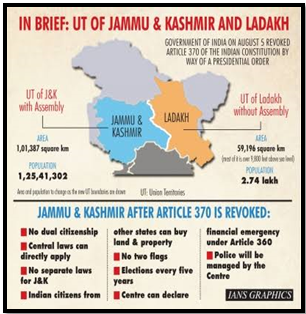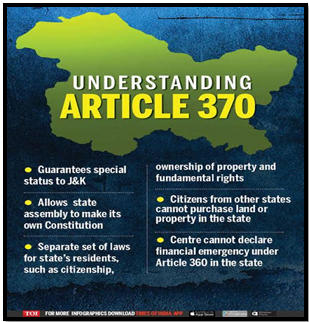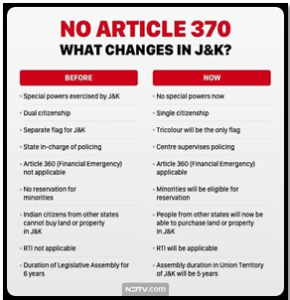ARTICLE 370 JUDGMENT: A CASE OF CONSTITUTIONAL MONISM:
Syllabus:
GS2: Issues and Challenges Pertaining to the Federal Structure
Key Points:
Article 370, Special Status of Jammu & Kashmir , Abrogation of Article 370, Supreme court , Lt. Governor , Instrument of Accession.
Why in the News?
More than four years post the abrogation of Article 370, the recent unanimous Supreme Court ruling has stirred discussions. While debates often revolve around the question of statehood, it’s crucial to recognize that the core of the matter lies in Jammu and Kashmir’s (J&K) special status.
Focus: Special Status of Jammu and Kashmir
- The focal point of the judgement lies in the special status of Jammu and Kashmir (J&K), overshadowed by discussions on statehood.
- The Court employs historical, textual, and structural interpretation, all rooted in constitutional monism.
Source: IANS
What is Article 370 ?
- Article 370, a provision in the Indian Constitution, granted special status to Jammu and Kashmir (J&K).
- It imposed significant limitations on Parliament’s legislative authority for J&K compared to other states.
- The enactment of Article 370 was a consequence of the Instrument of Accession signed by Maharaja Hari Singh, the former ruler of J&K, in 1947.
- Originally designed as a temporary measure, it facilitated the state’s transition from an independent princely state to a democratic entity within the dominion of India.
Source: ToI
Abrogation of Article 370 :
- On August 5, 2019, the President of India utilized powers under Article 370(1) to issue the Constitution (Application to Jammu and Kashmir) Order, 2019.
- This action involves modifications to Article 370 itself and doesn’t constitute a revocation of the article.
- The Government of India, through this order, has brought about significant changes in the relationship between the state of Jammu and Kashmir and the Indian Union.
Key Changes After 2019 Order:
Constitution (Application to Jammu and Kashmir) Order, 2019:
- Replaces the Presidential Order of 1954.
- The Jammu and Kashmir Reorganisation Bill, 2019, divides the state into two new Union Territories (UTs): Jammu & Kashmir, and Ladakh.
- Marks the first instance of a state being converted into UTs.
Representation and Legislative Changes:
- Of the six Lok Sabha seats, five go to the UT of Jammu and Kashmir, and one to Ladakh.
- Jammu and Kashmir will have a legislative assembly, while Ladakh will be a UT without legislature.
- Jammu and Kashmir will have a five-year assembly term, not six, and can make laws on various subjects except those related to “public order” and “police.”
Administrative Adjustments:
- Lieutenant Governor, similar to Delhi and Puducherry, replaces the Governor in Kashmir.
Special Status Abolished:
- Jammu & Kashmir loses its separate constitution, flag, anthem, and citizens no longer hold dual citizenship.
- As a UT under the Indian Constitution, citizens enjoy Fundamental Rights.
- Article 360, enabling the declaration of Financial Emergency, becomes applicable.
- All laws passed by Parliament, including Right to Information Act and Right to Education Act, now apply.
- The Indian Penal Code replaces the local Ranbir Penal Code.
- Article 35A, stemming from Article 370, is declared null and void.
Source: NDTV
Challenges in abrogation of Article 370:
Constitutional Challenges:
- Presidential order in 2019 altered Article 370, replacing “Constituent Assembly” with “Legislative Assembly.”
- The change redefined “Government of Jammu and Kashmir” as “Governor acting on advice.”
- This move aimed at diminishing autonomy without a constitutional amendment, challenged in court.
- The addition of Article 35A to the Indian Constitution through a Presidential Order faced scrutiny.
Union Territory Conversion:
- Transformation of Jammu and Kashmir into a Union Territory questioned Article 3 violation.
- The State Assembly’s non-referral of the Bill to the President raised concerns.
- Governor’s concurrence was deemed as the government’s concurrence, given the state was under Governor’s rule.
Federalism Concerns:
- Historical significance acknowledged in the Instrument of Accession.
- Court in Santosh Kumar case highlighted J&K’s unique status.
- SBI v Zaffar Ullah Nehru ruling held Article 370 repeal required the Constituent Assembly’s concurrence.
Supreme Court’s View / Key Decisions:
Sovereignty of Jammu and Kashmir:
- The Supreme Court, in a unanimous 5-0 ruling, declared that J&K lost its sovereignty after acceding to India in 1947.
- Maharaja Hari Singh’s proclamation retaining sovereignty was superseded by his successor Karan Singh, aligning with the Indian Constitution.
Legal Stands in Favour of Order:
- The court emphasized J&K’s integral part in India, referencing Article 1, Article 370 and J&K Constitution section 3.
- Section 3 of the J&K Constitution reads: “The State of Jammu and Kashmir is and shall be an integral part of the Union of India.” The state’s Constitution also provided that this provision cannot be amended.
- Section 147 of the Indian Constitution bars amendments to Section 3.This restriction is deemed absolute by the Court.
- The J&K Constitution’s Preamble lacks a clear reference to sovereignty, according to the Court.
Temporary or Permanent Nature of Article 370:
- The SC determined Article 370 as a temporary, transitional provision within the historical context and its placement in Part XXI of the Constitution.
- Chief Justice Chandrachud linked the “temporary” aspect to the wartime situation in 1947, justifying its inclusion.
Effective Abrogation of Article 370:
- The Court upheld both August 2019 presidential proclamations, crucial to abrogating Article 370.
- It interpreted the term “constituent assembly of Jammu and Kashmir” as “Legislative Assembly of Jammu and Kashmir,” endorsing the presidential actions.
- Referring to the 1994 ‘SR Bommai v Union of India’ ruling, the SC asserted that the President (Governor in this case) can assume state legislature roles during President’s rule.
- There was no prima facie evidence of malafide or extraneous exercise of power, following the Bommai interpretation.
Issue of Constitutional Monism :
Examining three key aspects where this monist approach is evident sheds light on the potential repercussions for federalism in India.
Federalism and Constitutional Sovereignty:
- Constitutional monism envisions the Union Constitution as the sole bearer of internal and external sovereignty, disregarding shared sovereignty under Article 370.
- Article 370 provided a framework for power distribution between the Union and State governments, not acknowledged in the judgement.
- The Court’s focus on a particular concept of sovereignty negates the shared sovereignty model of Article 370, essential in federal constitutions.
Contingency of Presidential Power:
- The judgement reflects monism in interpreting Clause 3 of Article 370, dismissing the notion of its permanence after the Constituent Assembly’s dissolution.
- The Court asserts unbridled power for the President to abrogate Article 370 without the Constituent Assembly’s concurrence, defying federalism and constitutional democracy.
- It fails to recognize the contingent nature of presidential power, persisting beyond the Constituent Assembly’s dissolution.
State’s Views on its Future:
- Monism portrays popular sovereignty as a monolith, undermining the binding nature of a State’s views for reorganization.
- Justice Sanjay Kaul emphasizes obtaining views from the entire nation through Parliament, subordinating the popular sovereignty of a State to the nation.
- The Court’s reliance on monist principles diminishes the significance of the people’s voice in J&K, particularly concerning reorganization.
Way Forward:
- Promotion of Tourism: Promote the region’s tourism potential to attract visitors, contributing to economic growth.
- Comprehensive Outreach Programme: Mitigate challenges arising from the changes in Article 370 by launching a comprehensive outreach program targeting all Kashmiris.
- Community Engagement: Encourage community participation in decision-making processes, fostering a sense of ownership.
- Respect for Local Culture and Identity: Uphold and respect the unique cultural and historical identity of the region.
- Zero-Terror Incident Plan: Continue the ‘zero-terror incident’ plan initiated in 2020, with the aim of achieving success by 2026.
- International Cooperation: Seek diplomatic engagement and cooperation on regional issues to ensure stability and development.
- Decadal Strategy Implementation: Implement a 10-year strategy focusing on education, employment, and employability (3Es) to uplift Kashmir.
- Adoption of Gandhian Principles: Advocate the adoption of Gandhian principles of non-violence and peace to address the legitimacy crisis in Kashmir.
The Supreme Court’s unanimous ruling emphasizing J&K’s integral part within India and interpreting key provisions through a constitutional monist lens. While the judgement addresses legal challenges, concerns about federalism, presidential power, and the people’s voice remain. Moving forward implementing comprehensive development plans are crucial for J&K’s stability and prosperity.
Mains Practice Question:
Critically analyze the Supreme Court’s Judgement on the abrogation of Article 370 in the context of constitutional monism. How does the judgement impact the principles of federalism and the special status of Jammu and Kashmir?

 Source: IANS
Source: IANS Source: ToI
Source: ToI Source: NDTV
Source: NDTV

